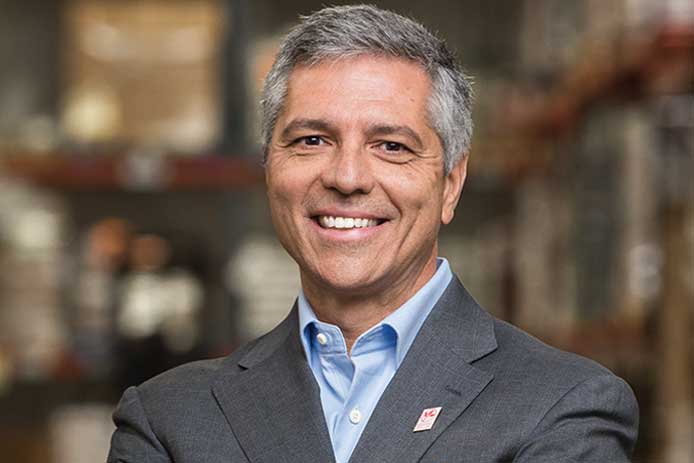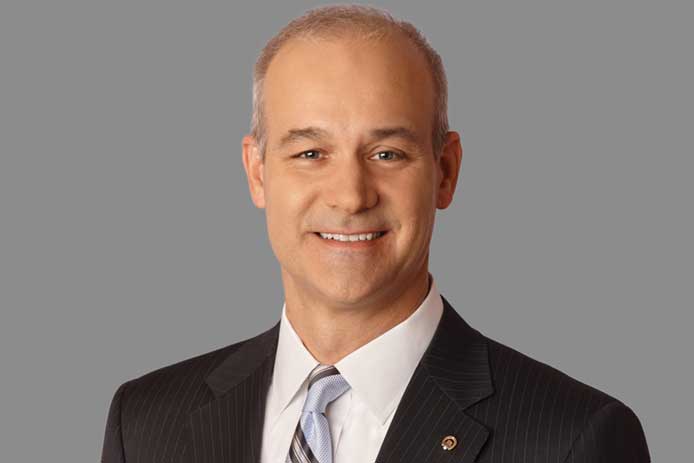Hearts, Hands and Hope, the 2020 MFB Annual Report

Positioned to Do More, and Do Better
The Maryland Food Bank started Fiscal Year 2020 (FY20) with great momentum after coming off our 40th anniversary celebration and entering the second year of our strategic plan. Our market-driven approach, evolving programs, newly strengthened partnerships, and emphasis on root cause solutions were taking hold, and we could see the benefits of our efforts. We were excited and hopeful… and then COVID-19 struck.
Immediately, our focus shifted to responding to this unprecedented global event. Fortunately, we were built for this. Our strong partnerships, statewide network, highly trained and talented staff, and stellar reputation allowed us to pivot and react quickly to the extraordinary need created by this pandemic.
And now, despite the continuing challenges brought on by COVID-19, the team at the food bank remains hopeful. As you are reading this publication, highly effective vaccines are rolling out. It finally seems possible that the pandemic will wind down.
But there is no vaccine for hunger, and the financial impact of this pandemic will continue to be felt by too many for years to come. We will be there for them tomorrow, as we are today, inspired by the goal of the next phase of our COVID-19 response — helping millions of Marylanders become food secure for good.
Our mission begins with a commitment to feeding people, and FY20 pushed us to do more of that than we ever thought possible. While the organization was operating without a roadmap, the governance structure we had built over the years worked. MFB’s Board and leadership team were in touch regularly. And, while we had more questions than answers in those early days, the Board had — and has — complete confidence in the food bank’s staff.
Early on, it became obvious that ‘business as usual’ would have to be completely redefined. Just one year ago, MFB was a $20 million annual revenue organization (excluding the value of donated food), and like most nonprofits, the organization aimed to end each fiscal year at a breakeven, which we often did.
But due to COVID-19, MFB needed to double the amount of food distributed and rapidly develop safe, new ways to reach communities statewide. So, in mid-March we crafted a 90-day $12 million plan to ensure that twice as much food would move through our statewide network compared to the beginning of the year.
But just as we began to settle into the now familiar reality posed by the multiple threats that the Coronavirus brought, our national suffering reached new heights with the death of George Floyd in late May.
Courageous Conversations About Race and Inequality
As May turned to June and protests spread across the nation, inside the food bank, and elsewhere, conversations about structural racism and inequality pushed staff to work together, find our voice, and make our stance clear:
We stand in solidarity and condemn all acts of racism and oppression. We are committed to serving all in need of food assistance.
In our more than 40 years of feeding Maryland, we have seen firsthand the impact of racial inequality and structural barriers to food access. While ending hunger has always been MFB’s priority, we acknowledge that it is incumbent upon us to do more and create further avenues for change.
Timing and the Year Ahead
The outpouring of generosity that came in those last months of FY20 was simply astounding, as longtime supporters were joined by thousands of new donors. In the last three and a half months of FY20, the food bank received 962% more in philanthropic revenue than during the same timeframe the year before.
Additionally, due to strong relationships with the State as well as local jurisdictions, MFB was the beneficiary of Federal relief dollars (with appropriate restrictions and timelines) to provide an equitable distribution of food to the 22 jurisdictions we serve.
We moved quickly to deploy those resources, spending over $8 million on food purchases between March and June, a 400% increase. But while quarantines and stay-at-home orders helped Maryland stay safe, the food economy collapsed. Restaurants closed, and the food supply chain broke, severely limiting our ability to purchase additional food. These supply chain constraints coupled with generous year-end support from our donors, meant the food bank ended our fiscal year with a significant cash balance.
Those funds not only allowed us to provide more than 45 million meals – nearly 55 million pounds – in FY 20 but will continue to fuel our heightened response going forward. In addition to record-setting food purchase levels, we provided grant funding to our Network Partners to keep them open and operational, enhanced capacity throughout our own operation, implemented new distribution methods, added new warehouse space and equipment, and provided COVID-19 protection for staff, partners, and volunteers. These early investments allowed MFB to nearly double distribution volume.
In FY21 (the year following this annual report), the food bank has continued to aggressively purchase nutritious food, spending an additional $12.5 million by December 31 alone (a 300% increase), and we know this trend will continue well into 2021.
And while generous support from the community continues to flow into MFB, our focus has shifted from how to spend funds quickly to how to invest funds wisely.
You Made the Difference
We see this annual report as an opportunity to thank you for the time, talent, and financial support you provide — the critical resources that allow us to successfully execute our mission.
During a crisis, food offers much more than calories; it indicates that someone cares. And thanks to you, we have been sharing that message regularly, and will continue to do so this month, this year, and for years to come. Thanks to your generosity, for the foreseeable future, MFB will be able to feed Maryland better.
Thank you.
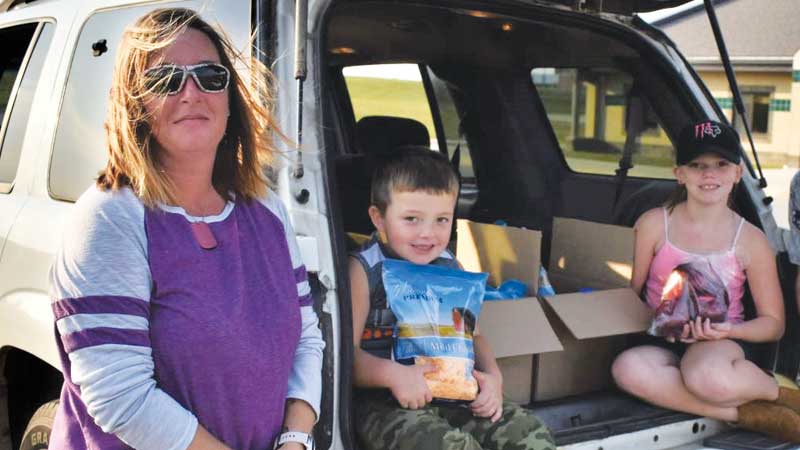
Managing through Crisis
Leading the food bank through those early days of COVID-19 was a textbook exercise in crisis management. The work that lay ahead was stripped down to the essentials and priorities became crystal clear. Many of the key resources, systems, and processes that MFB relied on had disappeared almost overnight.
The first step required to move forward was to make sure that the food bank could remain open and operational. Our staff needed to be able to provide essential services and remain safe. Next, we began to stabilize resources and rekindle relationships.
From there, the team moved swiftly to other critical needs: finding food, distributing it, and then securing funding to pay for a programmatic response that had doubled in size. Cost estimates, inventory levels, and program strategies were examined and by mid-March, MFB had a working plan. Analysis showed that to keep food flowing into the 22 jurisdictions we serve; it would cost an estimated $12 million dollars over the next 90 days.
The Maryland Food Bank leadership team huddled early each morning to evaluate options, make decisions, and eliminate distractions for the team. External events were canceled. The volunteer program collapsed.
Inbound call volumes and requests for assistance jammed phone lines. The level of need reached all-time highs, with demand for food nearly doubling.
“I’m so glad the food bank is open. That’s what helped make things less scary for me… that if the food bank was still willing to share food that we could then share with the public, then things were okay. It gave me some ease.”
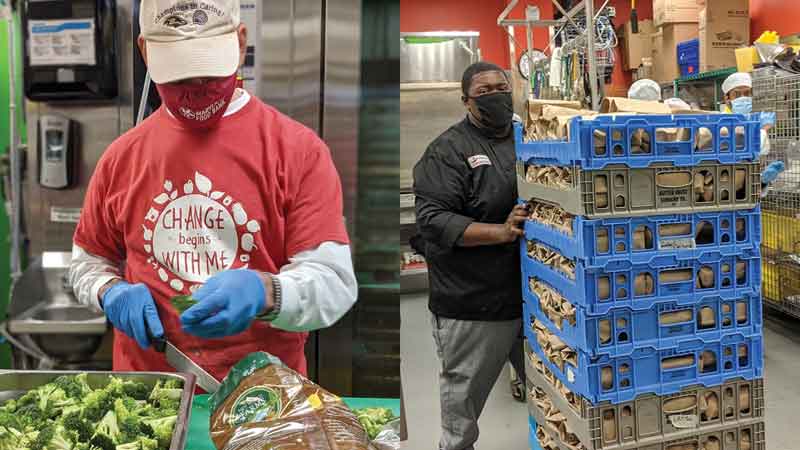
Finding Ways to Safely Feed Families
While distance learning has helped keep Maryland safe, it also presented new challenges for families who rely on school meals and pantries. Our Charles T. Bauer Community Kitchen suddenly became a problem-solving think tank. Typically, MFB’s meals are served “family style” which offers tremendous benefits but is not safe during a pandemic. The team from FoodWorks, our culinary training program, knew that they would have to begin producing individual Grab & Go Meals, but getting there took leadership, teamwork, and patience.
Tim Regan, Executive Director of FoodWorks, explained: “We had to re-learn everything we knew about how to get meals out. Schools were closed so the need to move fast was critical. We had access to food, but our challenge was pivoting from making big batches of pasta and cooked vegetables to making thousands of sandwiches and healthy snacks. It was not easy, but in a short time, the team built a program that is now producing over 15,500 meals weekly.”
This shift by our FoodWorks team was highly impactful to families like Jackie Green’s. “My food budget doubled with my kids at home. Being able to pick up these meals means a lot. It allows me to continue to work from home, while my kids can still go about their day with school. This program really helps because now I don’t have to do all the meals for them,” said Jackie, as she picked up food from Annapolis’ Stanton Community Center.
This new process changed the role of FoodWorks volunteers significantly. Today, volunteers are filling critical production positions and without them, the program simply couldn’t operate.
“One volunteer told me, ‘my schedule is more open than my wallet right now,’ and that reminds us all that while so many people are facing adversity, they still find ways to give,” Reagan continued.
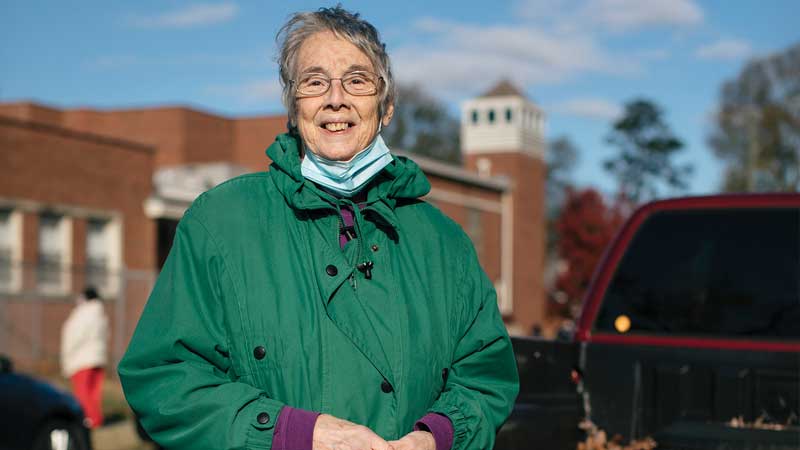
Getting Resourceful in Sourcing
In the early months of COVID-19, the single most critical challenge was a shortage of food. Rick Condon, MFB’s SVP of Operations, remembers how that felt.
“Our core ‘customer,’ food pantries and feeding programs, were telling us loud and clear that they couldn’t get enough food from MFB to feed the growing number of people showing up at their doorsteps asking for help. The disruptions to the supply chain really put a strain on us in a lot of ways. In early May, we only had about two weeks’ worth of food in house and it wasn’t necessarily very good food,” said Condon.
Of all the food typically distributed by MFB, about one-third is purchased and two-thirds is donated from food retailers and manufacturers or arrives in the form of government commodities. With the collapse of large-scale food donations, the food bank flipped its model and began buying food by the truckload.
But that swift shift just brought on a new set of obstacles. The vendors that MFB’s food sourcing team historically relied upon had sourcing challenges as well. Food orders were refused, and delivery dates stretched from two weeks to three months. Orders were only partially filled or even canceled without notice as the food supply chain crumbled under the multiple stresses brought on by COVID-19. The operations team needed to pivot, again.
“First we turned to the food service industry,” continued Rick Condon. “We started looking for new sources for food, like restaurants, that we didn’t have really strong relationships with. These places suddenly had excess food and no customers to serve.”
And so it continued. As new gaps or needs emerged, they were addressed one by one.
Thankfully, your support gave us the room to be agile, to learn, and to adapt to the ever-changing state of hunger. And when we didn’t have the expertise in house, we called on corporate, foundation, and government experts to ask for help. Everyone, it seemed, was fully committed to ensuring the Maryland Food Bank stayed open and operational.
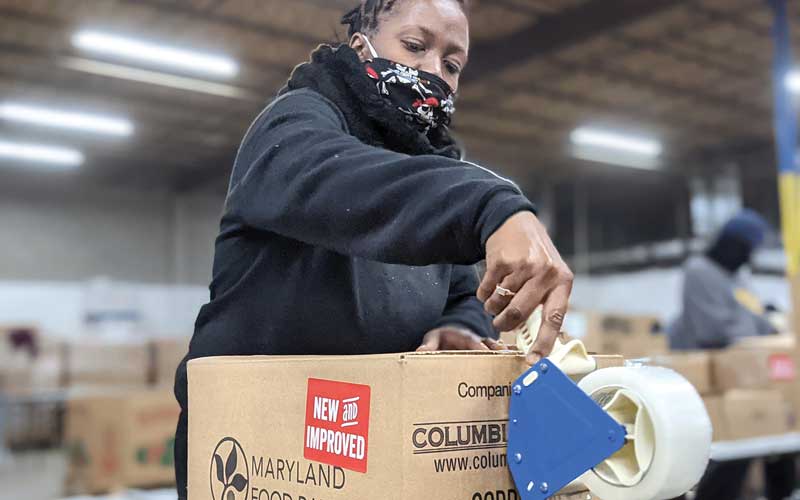
Back Up Boxes
In the early days of the pandemic, it was obvious that things needed to change. Gone were the days when an individual in need of charitable food could peruse the shelves of a food pantry and choose the items they preferred. In response to safety protocols and rapidly rising demand, many food banks — including MFB — quickly returned to an old idea: pre-boxing food.
And so, MFB’s “Back Up Boxes” were born. Affectionately dubbed “BUBs,” each Back Up Box provided 30-pounds of shelf-stable food that could safely and easily be transported, stored, and distributed.
285,505 Back Up Boxes
Distributed from March 1st through December 31st
“Initially, we thought volunteers would be able to build enough boxes to meet the growing need. It didn’t take long to realize that COVID-19 was having a much greater impact on hunger, and we needed a solution that would have a much greater impact on our neighbors in need,” MFB President & CEO Carmen Del Guercio recalled.
With the help of some local companies, within three weeks, the food bank stood up the new, offsite BUB production facility, staffed with 30 temporary workers who had recently lost their jobs in local restaurants or the hospitality industry.
FoodWorks Executive Director Tim Regan was the inspiration for outreach to the culinary community. “We knew that restaurant employees were going to be a great fit because many of them had just lost their livelihoods, and they also brought strong, transferable skills.”
The BUBs produced at the new facility proved to be an excellent solution, getting critically needed food quickly into local communities around the state.
“Despite food shortages seemingly everywhere, you have come through for the residents of Sandtown-Winchester. Your drop offs have provided meals for many,” said Kassie Boykin, from Baltimore’s St. Gregory the Great Church.
“Thank you Maryland Food Bank for making sure people in Baltimore County who are food insecure, many for the first time, have meals to provide for their families.”
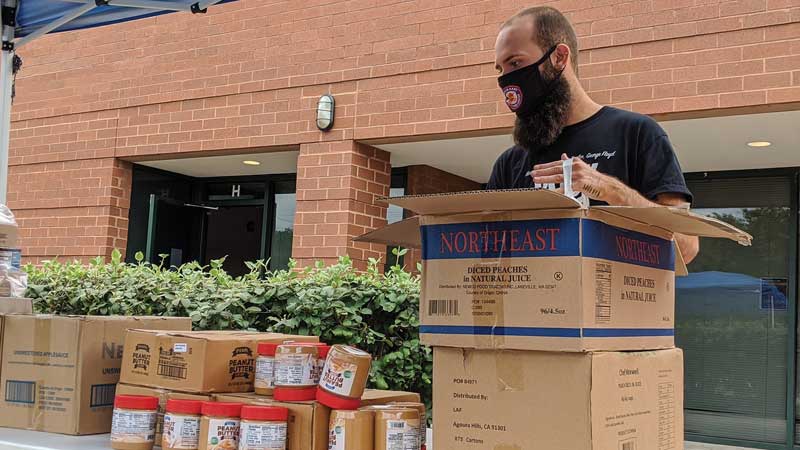
Taking Care of the Food Assistance Safety Net
While MFB’s Operations team scrambled to find food, the Programs staff was frantically reaching out to our network of food pantries and feeding programs. There was concern that the network itself might collapse. Food pantry coordinators told MFB they did not know what to do. “They didn’t know if they should open due to safety concerns, and others were unsure if they were allowed to open given stay-at-home orders,” recalled MFB EVP Meg Kimmel.
“People are scared, honestly, but we are trying to do our best at this point. With the help of the Maryland Food Bank, we’re able to run our pantry pretty well,” said Shyam Pandey of Catonsville’s ISKCON Food Pantry.
Again, partnerships made all the difference in those early days. This time it was Maryland’s Department of Human Services (DHS), Office of Emergency Operations. DHS lead planner for food access Bethany Brown, an expert in emergency response, called MFB in mid-March and simply asked, “Can I come over and talk with your team this afternoon?” From there, a highly effective partnership was created.
Brown launched a weekly call to local emergency management personnel, nonprofits, and other state agencies that began with one simple message: “As a part of the food supply chain, you are essential. Please stay open and stay operational… and we will help you to distribute food safely.” That’s where MFB stepped in.
Brown’s first call with over 400 participants soon became a bi-weekly webinar that MFB continues to orchestrate to this day, where valuable information, trainings, best practices, safety protocols, funding opportunities, and more are shared with hundreds of listeners statewide.
“From their first email informing us that we were an essential service and should remain open, to advice for safe operations, and providing free food and supplies; the Maryland Food Bank provided the support that we needed so we could continue to support our community,” said Wanda Singleton from Mt. Hope Ministry in Hagerstown.
To make sure there was enough food available for our network of partner agencies, MFB used grant dollars from public and private sources to purchase food and distribute it equitably across the state, from the western mountains to the Eastern Shore. This critical resource has made the difference for many food pantries and feeding programs who otherwise may have closed their doors.
“Our agency has had the privilege of working with many nonprofits through the years during disaster response. The Maryland Food Bank stands out as extraordinary in its ability to institute massive operational changes in order to meet the challenges required for feeding Marylanders during a prolonged disaster as quickly and as compassionately as it has.”
Looking Ahead
The agility and rapid response that 2020 demanded of MFB brought out the best in our organization and people, while revealing weaknesses in the food assistance safety net which we are actively strengthening. But knowing that it held up to the unimaginable strain of a global pandemic gives us the confidence that our Phase II COVID-19 response — which is currently underway — will continue to successfully support Maryland’s communities. And with you at our side, this “new normal” will be much brighter for all.
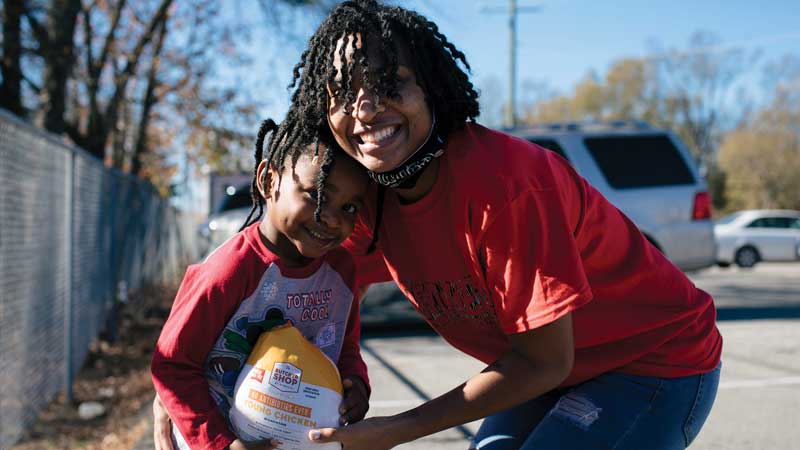
What’s Next
The work that lies ahead of us is more challenging than anything we have ever faced, especially when it comes to ensuring we remain good stewards of the financial resources you have entrusted in us. But the journey we have embarked on over the past four years has positioned us well for the future.
We know that it is not enough to feed people today if we are not helping more Marylanders become food secure tomorrow.
We know that it is imperative that we address the systemic barriers that face too many Maryland communities of color, including inadequate access to good quality, nutritious
food.
We know that these solutions are not always possible from one year to the next, but will take years of sustained effort, advocacy, and a commitment to doing better.
On behalf of the entire staff and Board of the Maryland Food Bank, we simply say: we know we can do this, but only if you are with us.
Maryland Food Bank Annual Report 2020
Download the entire annual report for off-line viewing.


